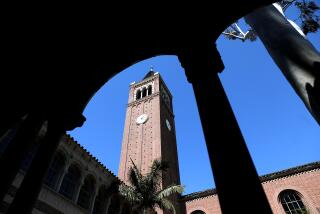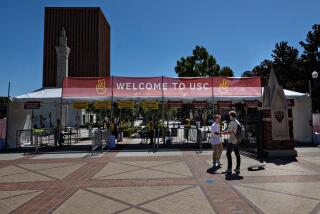Limit Set on New Students at SDSU
- Share via
The California State University chancellor’s office and San Diego State University have agreed in concept to cap enrollment of incoming freshman and transfer students at crowded SDSU to a total of 33,000 students.
The move would allow SDSU to strictly enforce existing regulations requiring an incoming freshman to have four years of college preparatory English and three years of college-prep math, university officials said.
Enrollment reductions this year caused by state budget cuts have led university officials to believe, however, that the new controls will not have to be implemented until 1993.
Previously, SDSU admitted all students applying during November, the traditional admissions period, provided they met grade point average and test score requirements. About 10% of the 12,000 students who applied last year did not meet the extra course requirements, said Frank Medeiros, associate vice president of academic affairs at SDSU.
The policy in effect would cap total enrollment at the current 33,000 students, he said. In recent years, total enrollment at the university has reached as high as 36,000.
“No firm decision has been made yet, but we’ve agreed to it in principle,” said Cal State University system chancellor Barry Munitz, who will meet with officials from SDSU and Cal State San Marcos within the week to hammer out details of the plan.
SDSU would become the first Cal State campus to be allowed to limit total enrollment since the mid-1970s, when Cal Poly San Luis Obispo was given similar authority. Since then, enrollment at Cal Poly has declined, and the policies are no longer in effect.
Medeiros stressed that SDSU has not raised its grade point average or test score requirements.
“It’s not anything bold and new, like raising the eligibility index. It does represent fine-tuning in terms of the requirements and so forth,” Medeiros said.
The university would also be allowed to give preference to residents of San Diego and Imperial counties, Medeiros said.
“It’s just a way of saying up front to not even think of applying if you don’t meet the criteria,” he said.
Munitz said the success of the proposal will depend in part on the ability of other colleges in the area, such as Cal State San Marcos, to absorb students who are not accepted at SDSU.
“You’ve got to be sure that there is continued access to the system,” Munitz said.
The policy would only kick in if the number of otherwise eligible students exceeds the 10,000 to 12,000 applicants each year that the university can accommodate, Medeiros said. Last year, the university had 12,000 applicants, he said.
“We’re right on the line there, and that’s why we’re not sure if we’ll have to use the criteria or not. It’s going to be close,” he said.
Medeiros said the new requirements would not curtail the enrollment of ethnic minorities or other at-risk groups. An analysis of SDSU students who didn’t take the extra math and English courses shows that they were not predominantly from one ethnic group, he said.
Students not admitted could appeal their rejection to a university board, Medeiros said.
Several University of California campuses, including UCLA and UC Berkeley, have for years been allowed to reject students even though they have met the base eligibility requirements, Munitz said.
More to Read
Sign up for Essential California
The most important California stories and recommendations in your inbox every morning.
You may occasionally receive promotional content from the Los Angeles Times.










